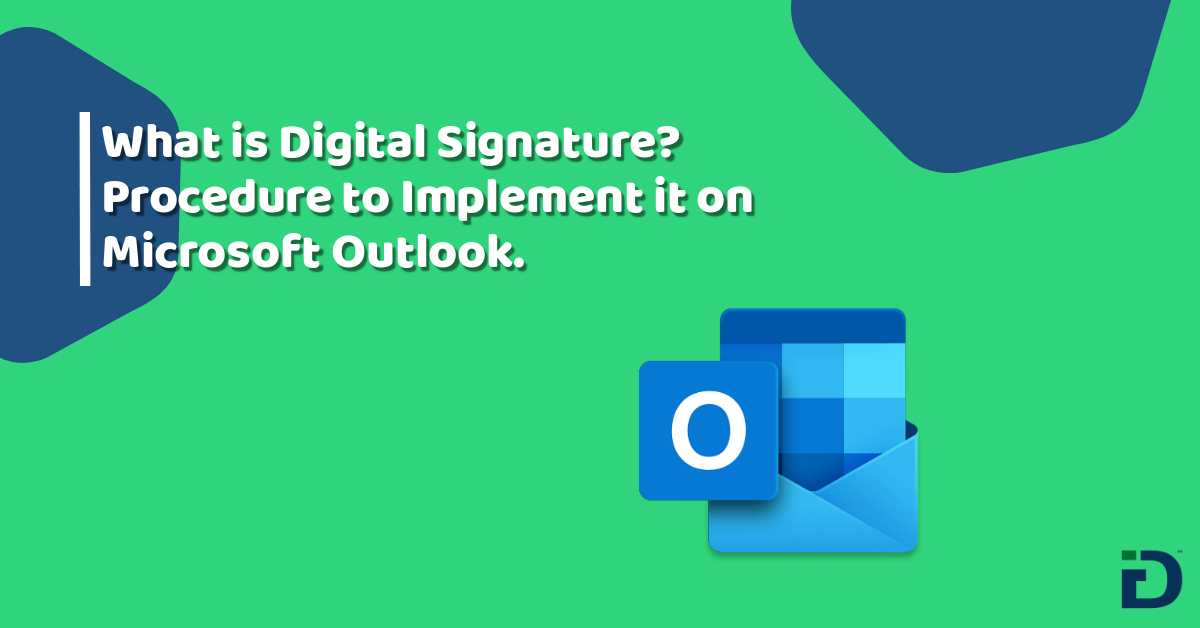

Contact
+91 8591174212Let's work together to bring your products and services to new digital heights!
Get in Touch

Aug 21, 2020

In today’s hyper-connected world, traditional methods of signing and authenticating documents are increasingly being replaced by technological innovations such as electronic signatures in general and digital signatures in particular. India is sprinting towards a digitized world and the Information Technology Act (IT Act), passed in 2000, granted e-signatures the same legal status as handwritten signatures.
Before we dig deep into the advantages and procedure of implementing a digital signature on outlook, let us learn what is a digital signature.
A digital signature is a mathematical scheme for verifying the authenticity of digital messages or documents. An electronic signature is not a signature typed into an email or a signature that has been handwritten and scanned. The term refers to an online signature attached to a record and adopted by an individual with the intent to sign it.
An authenticated digital signature is when the prerequisites are fulfilled by the sending. It not only gives a sense of authenticity (that the message was created and sent by a known sender) but also integrity (that the message was not edited/tampered while in transit. This gives the receiver of the mail a very strong reason to believe that a sender is a genuine person.
Electronic signatures generally consist of four basic components that you need to fulfill in order to generate one for yourself.
1. A means of signing,
2. A way of authenticating the related data,
3. Authentication of the signatories,
4. The capture of the signatories’ intent.
An E-signature technology would generally include items such as personal identification numbers (PINs), biometric markers, and other user identification processes.
1. Added security: A digital signature offers more security than an electronic signature. The unique and authenticated “fingerprint” data in a digital signature remains permanently embedded within a document. Signatures that someone has attempted to tamper or tried to alter data in a document after signing it can be easily tracked.
2. A high standard: PKI offers an algorithmically based protocol in which a vendor generates two “keys,” the lengthy numbers that define the signature. One of the keys is private and the other is public.
The PKI standard states that vendors who help you generate and save keys have to follow a safe and secure method to do so. The standard also communicates that the services of a trustworthy Certificate Authority should be used to ensure security.
3. Non-repudiation: Non-repudiation is an important aspect of digital signatures. By this property, a party that has signed some information cannot later deny having signed it.
4. Global acceptance and legal compliance: Most countries around the world are accepting digital signatures on legally binding documents because they understand that the security protocols offered by various vendors are in compliance with international standards in the industry.
5. Long-term retention and access: The signatories to a digital signature document do not need to rely on the tenure of a vendor’s presence in the industry marketplace.
6. Evidence: Digital signatures help identify and authenticate signatories, and collect data that can later serve as evidence. They also allow obtaining an audit trail if necessary.
7. More agile workflow: Multiple digital signatures can be obtained in less time, streamlining administrative and legal processes.
8. Cost savings and environmental sustainability: You can save costs by reducing the amount of paperwork, prints, copies, stamp equipment, filing space and investment in files. You can safeguard your documents digitally whereas with the paperwork you are afraid of them getting destroyed or tampered physically.
9. Access from anywhere and at any time: Whether you are in the office physically or outside, the digital signature brings the advantage of being able to be used wherever needed giving you the flexibility of mobility.
Step 1: Press the “Info” button. Then press the “Options” button.
Step 2: The below layout will open with “General” tab being the default selection.
Step 3: Go to “Trust Center”. Click on the “Trust Center Settings” button.
Step 4: Click “Email Security” (left side) then click on “Import/Export”.
Step 5: Browse and import your digital certificate.
Press “OK” once done.
Cloud computing is the need of the hour due to this current pandemic situation. Automating your signature could be the first critical task you must consider in your office automation project. Here are the other 8 simple office tasks you can automate this quarantine. Hope this blog helps.
Let’s build a smarter, more connected future for your business. Get in touch with us today!

Office Address
6th Floor, Office Number 603, Ashok Premises, Old Nagardas Crossroad, Opposite Saraswati Towers, Andheri East, Mumbai, Maharashtra 400069
info@idigitize.co
Contact
@ 2024, iDigitize I All Rights Reserved I Designed, Developed & Managed By iDigitize Infotech LLP